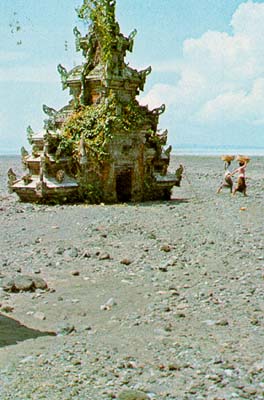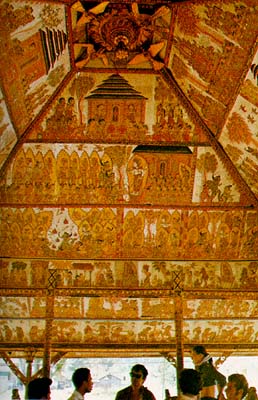
Klungkung
|
|
As the
seat of the Dewa
Agung, nominally the highest of the old Balinese rajas, Klungkung holds
a special place in the island's history and culture. As artistic
centers, the palaces of Klungkung's rajas and noblemen patronized and
developed the styles of music, drama and the fine arts that flourish
today.
|

|
|
The
capital was shifted
to Klungkung from nearby Gelgel in 1710, and a new palace built.
Probably towards the end of that century the original Kerta Gosa, Hall
of Justice, was erected. An exquisite example of the Klungkung style of
painting and architecture, the present Kerta at the town's main
intersection is beautifully laid out within its moat. Three Brahmana
priests acting as judges presided over this royal court which continued
in existence through Dutch times.
|
|
Cases were
brought here
only if they could not be settled among families or individual
villages, as the Kerta was the island's highest court of justice and by
far the strictest. Imagine a terrified defendant kneeling before the
tribunal, his gaze chancing to wander to the ceiling on which were
painted scenes of the horrors he would meet after death, were he
guilty. If he dared to look higher, he found each punishment
complemented by a reward in heaven. At that time, perjury could bring a
curse upon three generations.
|

|
|
The Bale
Kambang, the
Floating Pavilion, likewise decorated, was used by the attending royal
family. Pan Semaris and Mangku Mura directed the present paintings in
1945. Two kilometers south, between Klungkung and Gelgel, lies the
village of Kamasan, the present-day center of the Klungkung - style
painters. Indeed that style is often called the Kamasan or wayang
style, as it draws its main themes from Old Javanese literary classics,
brought here only if they could not be settled. Kamasan is also a
famous center of gold and silver smithing. In the shops of Klungkung
one can buy modern and antique Klunkung-style paintings, carvings,
silverwork and silks.
|

|
Copyright
2001-2015, K&D Bali Designs. All rights reserved.
|